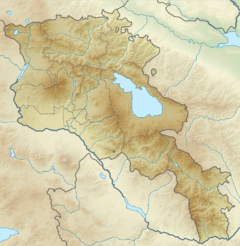Porak
| Porak | |
|---|---|
| Axarbaxar | |
 A pyroclastic cone of the Porak volcanic field. | |
| Highest point | |
| Elevation | 2,800 m (9,200 ft) |
| Listing | |
| Coordinates | 40°01′N 45°47′E / 40.017°N 45.783°E |
| Geography | |
| Countries | Armenia and Azerbaijan |
| Parent range | Vardenis |
| Geology | |
| Mountain type | Stratovolcano |
| Last eruption | 778 BCE ± 5 years |
Porak or Akharbakhar ("gutted belly" in Azerbaijani
The Porak volcano itself and the third stage has been dated 15 ± 15
Description
There are four stages of
Several archaeological sites (one of these dated by radiocarbon analysis on charcoal to be no younger than 3080±40 BP-3200±40 BP) are constructed on the two oldest Holocene stages but not on the most recent stage. Third-stage lava flows run at the edge of one of these sites which was constructed on lavas from the previous two stages, suggesting that the site was affected by historical volcanic activity. There is also evidence of strong earthquake activity 6640±90 BP and between 782 and 773 BC.[3] The volcano may have potential for geothermal power generation but is also a potential threat to several villages in the area.[5]
Khorkhor inscription
The
Older evidence of volcanic activity, including
References
- ^ S2CID 131294219.
- ^ "Porak". Global Volcanism Program. Smithsonian Institution. Retrieved 20 July 2015.
- ^ ISSN 0377-0273.
- ^ "Porak". Search. Volcano Global Risk Identification & Analysis Project. May 2, 2012. Retrieved July 21, 2015.
- ^ ISSN 1871-1014.
- ^ ISSN 0377-0273.
- ISSN 0377-0273.
- PMID 26745626.


